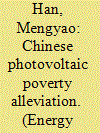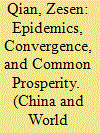|
|
|
Sort Order |
|
|
|
Items / Page
|
|
|
|
|
|
|
| Srl | Item |
| 1 |
ID:
128417


|
|
|
|
|
| Publication |
2014.
|
| Summary/Abstract |
Increasing use of energy has helped to stimulate China's economy. Despite central planning, China has great differences in economic development, energy endowment and energy consumption across its regions. This paper uses the structural decomposition approach to uncover the regional disparities in energy consumption from 1987 to 2007. We also examine six possible key factors for the change in energy consumption by region. We find that final demand change outpaced efficiency improvements to drive up energy use in all regions between 1987 and 2007. More surprisingly, from 2002 to 2007, it appears that changes in production structure enhanced energy consumption in most regions. China produced more energy-intensive goods for capital investment and export. We contend that improving the energy efficiency of key energy-intensive sectors would lead a significant decline in energy intensity. Energy, directly or indirectly, is flowing from Northwest, Central and North China to coastal regions. Regional-specific policies should be designed to promote production structure change and curb energy demand.
|
|
|
|
|
|
|
|
|
|
|
|
|
|
|
|
| 2 |
ID:
113679


|
|
|
|
|
| Publication |
2012.
|
| Summary/Abstract |
This paper assesses both interregional and intraregional innovation inequality in China from 1995 to 2006. It is revealed that the east-central-west inequality has increased over time, whereas the inter-provincial inequality showed a V-pattern until 2003; Both inequality measures oscillated from 2004 to 2006. Using a decomposition framework recently developed by one of the authors, we determined that the major factors driving innovation inequality are population, economic development level, R&D, location and openness. The aggravated innovation inequality reflects the growth of China's innovation centers in the eastern region and their admission into the global innovation networks. The fact that R&D is a major factor driving the inequality suggests that, considered in the present study, the efficiency of R&D investment improved in certian regions during the period (1995-2006). Finally, geographic location and openness affect innovation inequality primarily through the coupled evolution of innovation capability and economic development, resulting in first-mover advantages to provinces of the eastern region.
|
|
|
|
|
|
|
|
|
|
|
|
|
|
|
|
| 3 |
ID:
176889


|
|
|
|
|
| Summary/Abstract |
As a part of an environmentally concerned development strategy, the photovoltaic poverty alleviation in China is adopted to lift households above the rural extreme poverty line by the end of 2020. With the detailed project-level data in 534 counties, 22 provinces, this systematic assessment on Chinese photovoltaic power projects identifies geographic distribution, economic benefits and emission mitigation for deployment distribution and policy implications. Overall, the photovoltaic installed capacity has reached 5213.37 MW, with the income generation of 7.41 billion CNY per year and the carbon emission mitigation of 5.98 million tons. From the results in this work, it is obvious that the GDP and household savings per capita in most counties and cities are lower than in those without photovoltaic poverty alleviation stations. As an essential strategy of generating income and mitigating emissions especially in countries well-endowed with sunlight, the deployment of photovoltaic power projects is consistent with sustainable development goals relating to global poverty eradication. With the assessments on the photovoltaic power stations, the initial implementation of photovoltaic poverty alleviation revealed a number of problems and solutions, which are practical for systematic deployment and policy implications of relevant photovoltaic power projects worldwide.
|
|
|
|
|
|
|
|
|
|
|
|
|
|
|
|
| 4 |
ID:
176785


|
|
|
|
|
| Summary/Abstract |
Whether there will be a long-run equilibrium (steady state) in energy demand per capita is a critical question for energy and environmental policy makers. While many studies have been done on energy production and energy consumption, little attention has been paid to whether disparities in relative household energy consumption (RHEC) converge, and how the use of aggregated data has serious limitations. This paper is the first study to investigate the convergence and dynamics of household energy consumption in China. The results are helpful to Chinese policy makers when trying to identify the key groups for priority interventions. The study finds that variability in the RHEC is very high and that many households will likely change their energy consumption patterns in the coming years. Overall, Chinese households have two convergence clubs. The current dynamics will probably lead to lower energy consumption for most households. The study suggests that policy makers should pay particular attention to households that have too low or too high RHEC level, mainly in rural areas and in the western region.
|
|
|
|
|
|
|
|
|
|
|
|
|
|
|
|
| 5 |
ID:
191415


|
|
|
|
|
| Summary/Abstract |
Regional disparity and energy poverty are major challenges for India on a macro-scale. In this study we explored regional disparity and energy poverty in India's future by formulating a series of unique mathematical functions while analyzing historical time-series of per-capita energy consumption (PEC). The functions formulated have important implications on India's approaches towards rapid urbanization, access to clean energy, and rural electrification. We also analyzed end-use energy consumption in low, mid and high-developing states and examined the impacts of the uncertainty of socio-economic changes. As per our estimates, energy consumption in urban areas, is likely to grow by 3.6 times from 2010 to 2070, whereas that in rural areas is likely to decrease by 0.6 times. Energy poverty among Indian states narrows by 2050, while energy consumption in the mid and high-developing states rises rapidly as urbanization and per-capita income increase. Even with this consumption growth, India's average household PEC in 2070 may remain lower than the world average recorded in 2010. The provision of advanced energy resources and technologies is therefore likely to be an important policy challenge for India, especially in the rural areas of low-developing states, as the country pursues its target of reducing energy poverty and regional disparity.
|
|
|
|
|
|
|
|
|
|
|
|
|
|
|
|
| 6 |
ID:
182582


|
|
|
|
|
| Summary/Abstract |
This article investigates the impact of previous epidemics on rural development and convergence, and identifies the impact's mechanism based on convergence tests. Using a balanced panel of 31 provinces, the empirical results from 2002 to 2019 show that epidemics decelerated convergence in rural per capita income. The mechanism analysis shows that the accelerated divergence in wages and the decelerated convergence in business income were the major drivers, which also led to decelerated convergence in rural per capita consumption. Although epidemics have not threatened rural food consumption and the Engel coefficient of rural households, these two indicators of basic living needs have failed to achieve convergence across regions. The overall impact of an epidemic on convergence in rural–urban income disparity has also been insignificant, indicating that epidemics have affected rural and urban development simultaneously. Finally, COVID-19 is likely to decelerate convergence in rural income, rural consumption, and urban income.
|
|
|
|
|
|
|
|
|
|
|
|
|
|
|
|
| 7 |
ID:
100753


|
|
|
|
|
| Publication |
2010.
|
| Summary/Abstract |
On explaining regional differences, the current literature emphasizes the difference in factor accumulations. This paper suggests an additional possibility that regions may differ in parameter values in their production functions. In terms of the Cobb-Douglas production function, regions may differ in the share of capital in income. Using the province-level data in China, this paper shows that capital shares have a very significant and positive effect on per capita GDP. In particular, the differences in production functions explain 46.6% of the difference in per capita output between the East region and West region in China. Further, using the firm-level data, we show that the differences in regional production function are likely due to different industry compositions.
|
|
|
|
|
|
|
|
|
|
|
|
|
|
|
|
| 8 |
ID:
101944


|
|
|
| 9 |
ID:
181619


|
|
|
|
|
| Summary/Abstract |
Increasing household energy consumption, mainly due to consumption upgrading, will create tough challenges for China if that country is to achieve peak carbon emissions in 2030 and carbon neutrality in 2060. However, this critical issue has not been explored comprehensively in the literature. Using China Family Panel Studies data and the distribution dynamics approach, this article is the first study to examine the relationship between quality of life (QOL) (proxied by consumption upgrading) and relative household energy consumption (RHEC). The results show that convergence clubs exist in all QOL groups for the RHEC, but they are more evident in the groups with lower middle and low QOL. This is encouraging because they suggest that an improvement in QOL does not necessarily lead to a higher level of energy consumption. The dataset was then divided into rural-urban and regional subgroups to further explore the impacts of these different characteristics on energy consumption. Significant disparities are found among the same QOL groups between urban and rural households and among different regions. The results derived from this study lead to pragmatic policy suggestions in areas including energy saving, emissions reduction, and particularly alleviation of inequality.
|
|
|
|
|
|
|
|
|
|
|
|
|
|
|
|
| 10 |
ID:
093837


|
|
|
|
|
| Publication |
2010.
|
| Summary/Abstract |
While China's growth has been spectacular over the past 30 years, it has masked growing underlying disparities in the regional distribution of income with coastal provinces growing at a much faster rate than the rest of the country, exacerbating already marked differences in per capita income. Policy focused on addressing these growing disparities has had to face the possibility that spreading growth more evenly around the country will require a sacrifice of the national growth rate. Yet there is almost no empirical evidence that this is so and, if it is, how big the required sacrifice is. This paper contributes to filling this gap by analyzing the relationship between aggregate growth and the inequality of regional output distribution. We use a VAR model to simulate the effects over time on growth of a reduction in inequality and also the effects on inequality of an increase in growth. We find, first, that in the long run a more equal distribution can be obtained without a growth sacrifice. Second, in the short run a reduction in inequality reduces growth. Third, in the short and long runs an increase in growth actually reduces inequality.
|
|
|
|
|
|
|
|
|
|
|
|
|
|
|
|
| 11 |
ID:
125651


|
|
|
|
|
| Publication |
2013.
|
| Summary/Abstract |
With rapid development, increasing sulfur dioxide (SO2) emission becomes a key environmental issue in China. To respond to this challenge, the Chinese government established a top-down scheme to reduce its SO2 emissions. However, regional disparity and the associated cost differences brought uncertainties to the policy effectiveness and efficiency. Few studies focus on this field. Therefore, this study tries to fill such a gap by investigating the differences of SO2 emissions, reduction potential, and cost-effectiveness through use of the GAINS-China model in five mega-cities in China, namely, Beijing, Shanghai, Tianjin, Chongqing, and Hong Kong. A scenario analysis approach is employed, focusing on two technologies named flue gas desulfurization (FGD) and limestone injection (LINJ). Results demonstrated that a large SO2 reduction potential exists, as well as a great disparity, among the five mega-cities. Chongqing had the largest reduction potential with lowest unit cost, while Beijng and Hong Kong showed the lowest reduction potential with higher unit cost. In Beijing and Shanghai, FGD and LINJ in the power generation sector had the larger reduction potential with the highest cost-effectiveness. However, in Chongqing, the industry sectors also had large reduction potentials. Finally, appropriate SO2 control strategies and policies are raised by considering the local realities.
|
|
|
|
|
|
|
|
|
|
|
|
|
|
|
|
| 12 |
ID:
124562


|
|
|
|
|
| Publication |
2013.
|
| Summary/Abstract |
Despite the "growth miracle" of recent decades, labor's share, i.e., the share of total labor compensation in GDP, has decreased in China. Labor's share is an important indicator of the primary distribution of national income, and its fall has drawn significant attention from researchers and policymakers. As China's many regions have different development levels and economic structures, it is very likely that labor's share will differ across regions. Thus, it is important to examine the regional disparity of labor's share. In this paper, we develop a conceptual framework based on existing theories to identify the factors that influence labor's share. We, then, use Chinese provincial data from 1997 to 2007 to describe the regional differentials in labor's share and its evolution over the 10-year period and to explain regional disparity in labor's share. We take into consideration spatial correlations across regions and employ spatial cross-sectional and panel models in the empirical analysis. We found that industrial composition and ownership structure were the two key factors that influence labor's share. We also found that the average labor income was lower but labor's share was higher in western areas compared to eastern areas. The higher levels of labor's share in western provinces may be explained by a higher share of agricultural industries and state-owned enterprises, as agriculture and state-owned sectors tend to distribute more income to labor than to capital.
|
|
|
|
|
|
|
|
|
|
|
|
|
|
|
|
| 13 |
ID:
136066


|
|
|
|
|
| Summary/Abstract |
This study examines the relationship between the fiscal intervention of the government and regional income disparity in 14 major Indian states. The impact of decentralization on the regional disparity of these states is also examined. The findings suggest that both policy measures have reduced the level of regional disparity. This study has also investigated the impacts of policy measures on regional income disparity within the clusters of states of similar income levels. Results suggest that both types of policy interventions have reduced regional disparity in low-income states, whereas only fiscal intervention is found significant in reducing regional disparity in middle-income states. Surprisingly, no relation is found between regional disparity and the policy measures in high-income states.
|
|
|
|
|
|
|
|
|
|
|
|
|
|
|
|
|
|
|
|
|